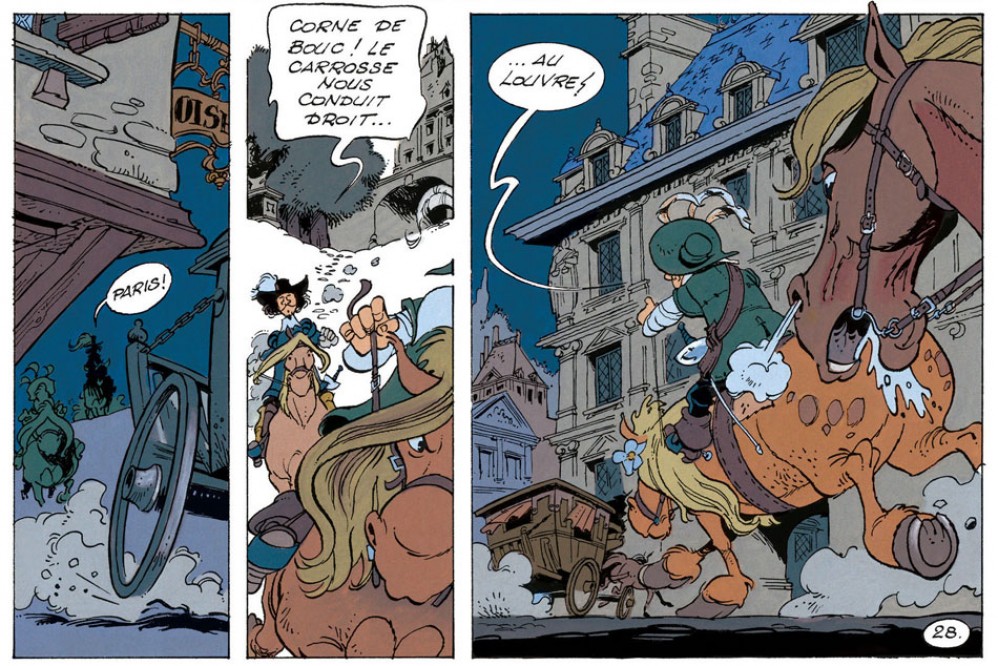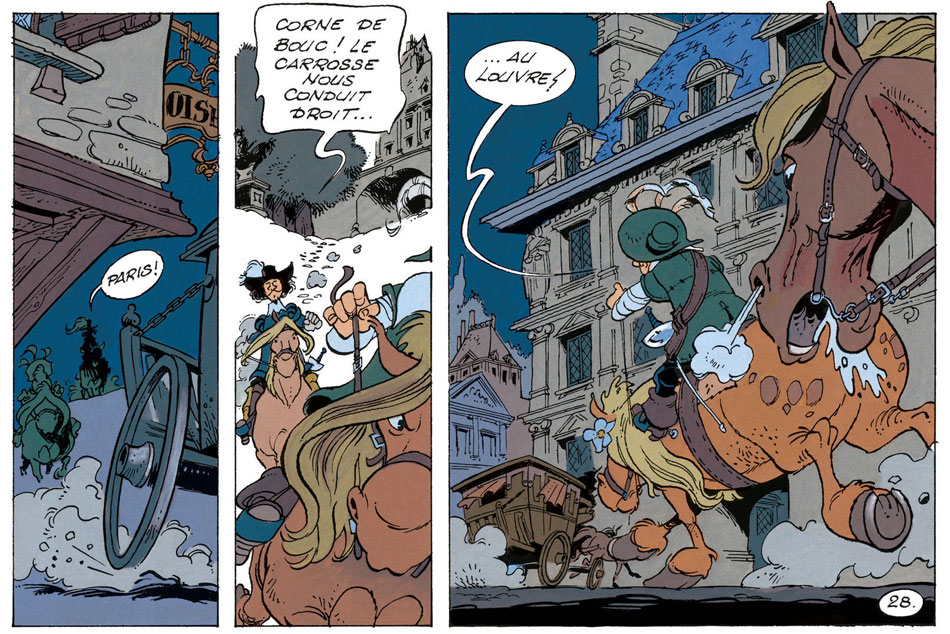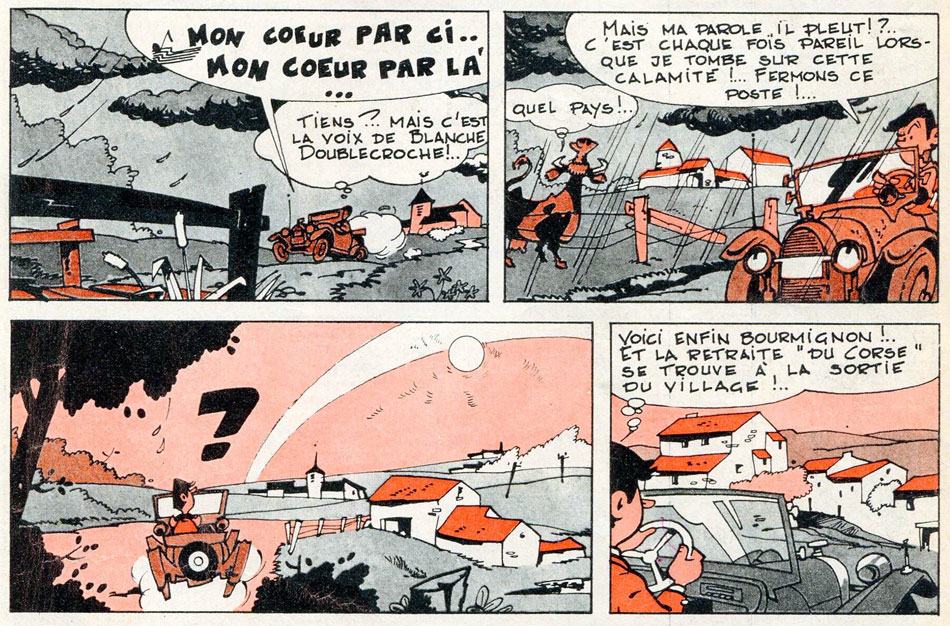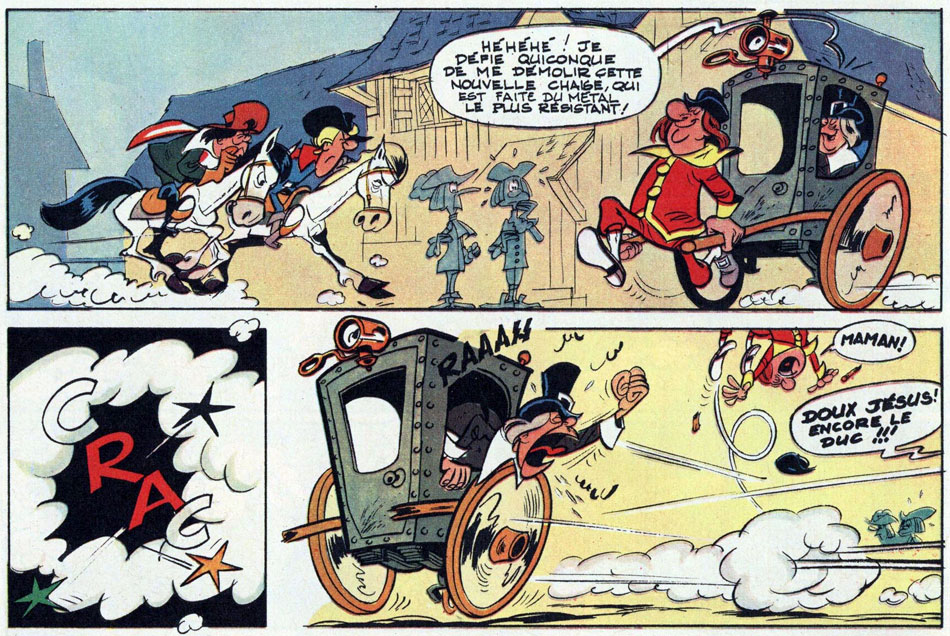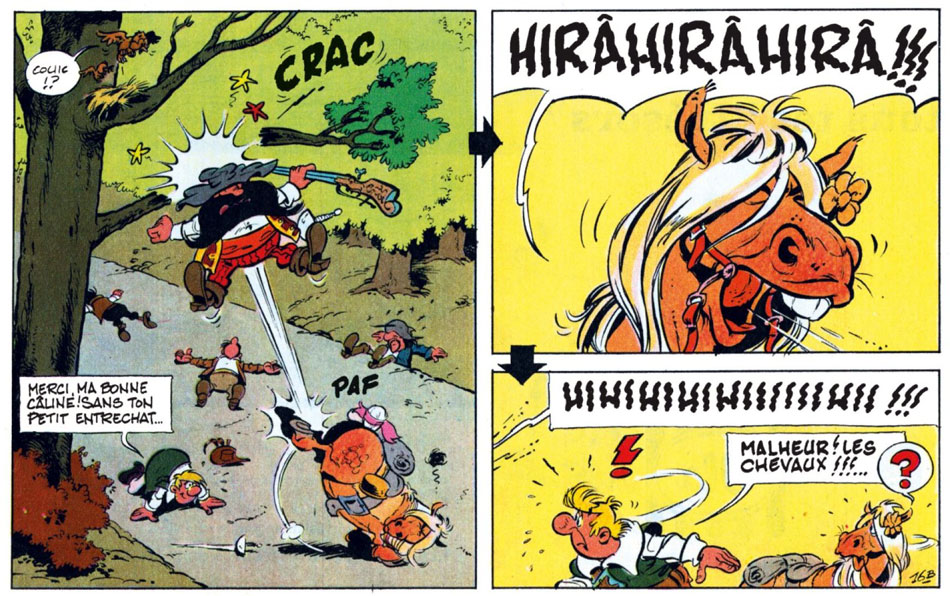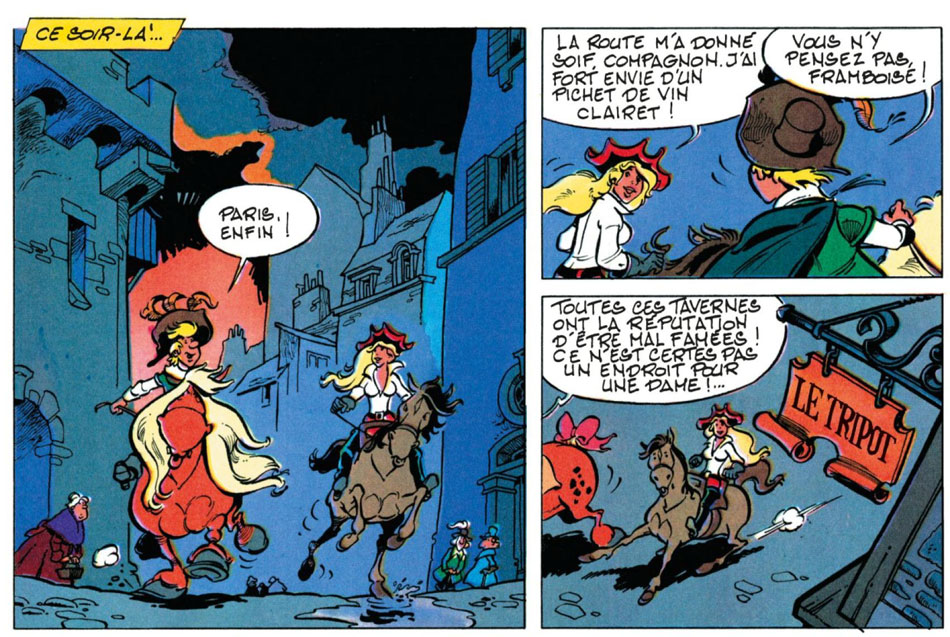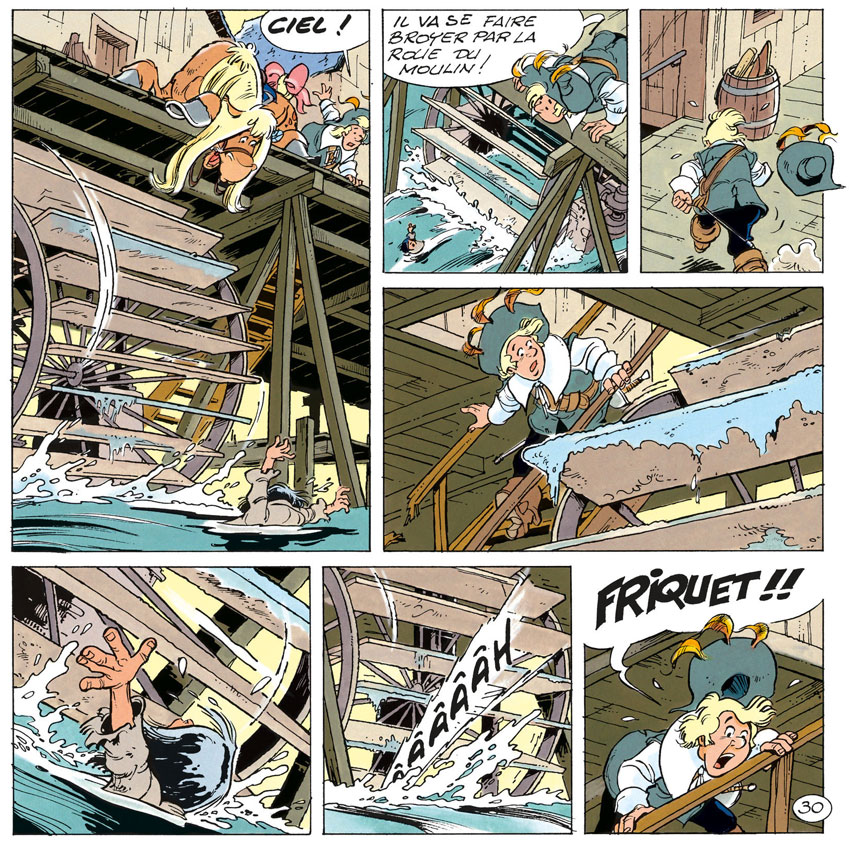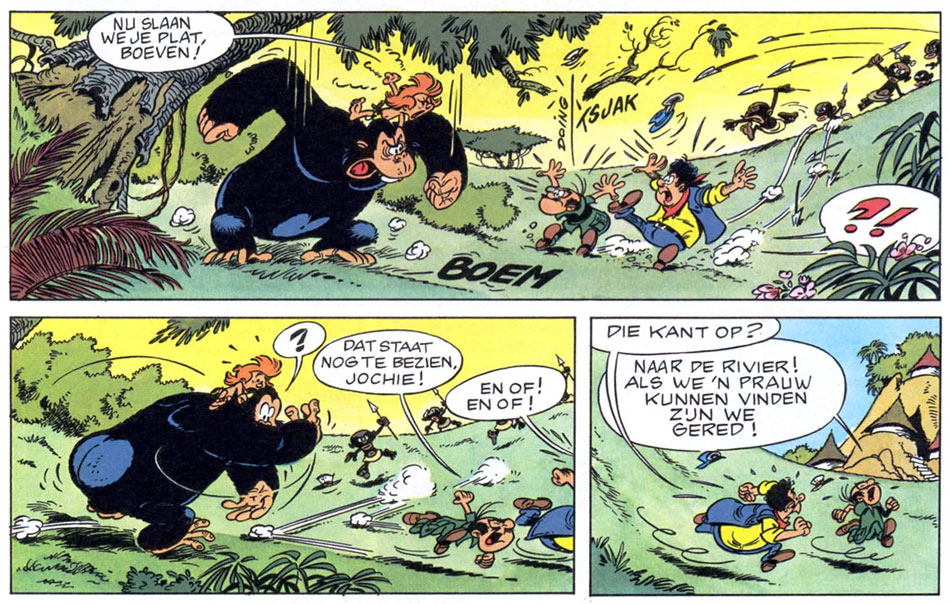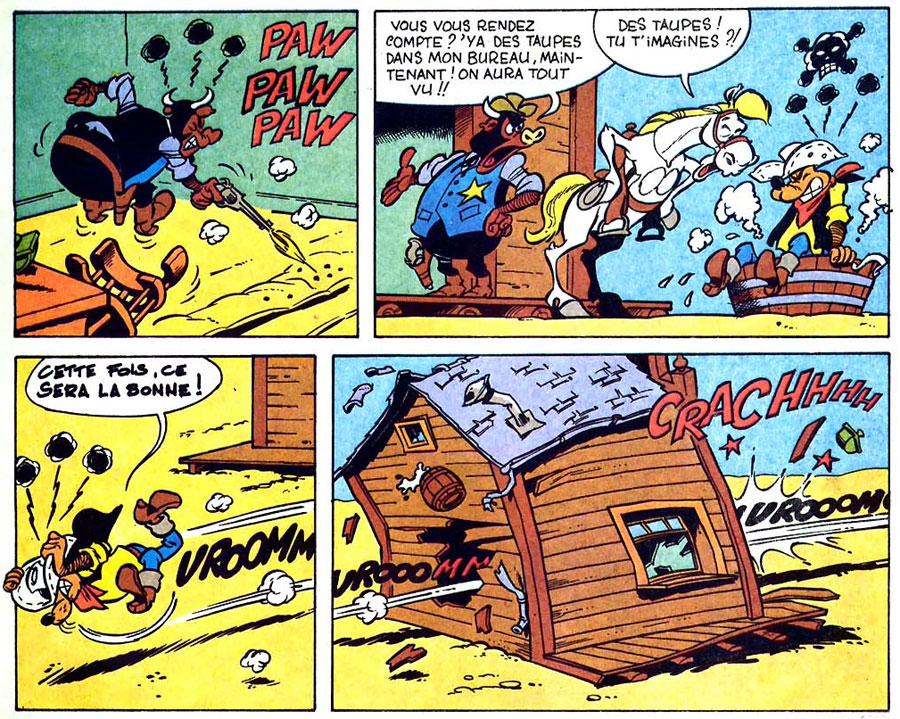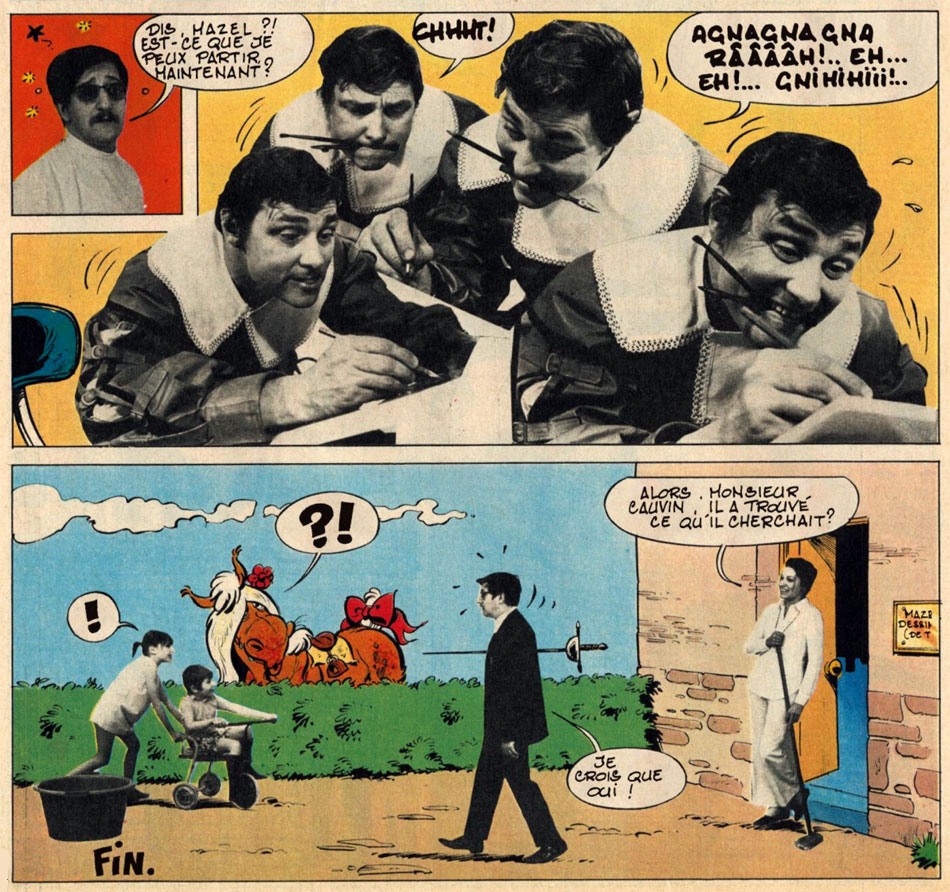Les Mousquetaires - 'Le Grand Secret' (1989).
Luc Mazel was a Belgian comic creator, and a longtime staple of Spirou magazine. After modest beginnings in titles like Tintin and Pilote, he was paired with scriptwriter Raoul Cauvin at Spirou. Together, they created humor adventure comics starring human-animal duos. First there were the musketeer Calebasse and his feisty mare Câline ('Câline et Calebasse', 1969-1976), then came the little jungle boy Boulouloum and the giant gorilla Guiliguili ('Boulouloum et Guiliguili', AKA 'Les Jungles Perdues', 1975-1987). During the 1980s, Mazel as a solo creator revived his musketeer comic under the title 'Les Mousquetaires' (1980-1992), initially as a gag feature and then as serials with a stronger focus on adventure and historical accuracy. During the final stages of his career, Mazel teamed up with Cauvin again to create the humor feature 'Les Paparazzi' (1993-2004), spoofing the society press. Mazel's career was often a bumpy ride, hindered by quirks and decisions of his editors and lack of commercial success, but still he stood out in Spirou for his vivid and dynamic artwork that could easily switch between hilarious slapstick and exciting semi-realism.
Early life
Luc Maezelle was born in 1931 in Herentals, in what was then still the Antwerp countryside. His father Germaine - a Frenchman originally from Bordeaux - regularly took Luc and his older brother Jacques out on nature walks. His mother ran a fabrics store and had her own sewing workshop. Their setting changed later in the 1930s, when the Maezelle family relocated to Anderlecht, one of the Brussels suburbs. For a boy like Luc this was a culture shock. As a four-year old, he suddenly moved from a rural Dutch-speaking region into a city where everyone spoke French. Growing up as a timid child, the boy found refuge in his father's book collection, with a particular fondness for the works of Jules Verne, Jack London, James Fenimore Cooper and Alexandre Dumas. As a Catholic, he also read Le Petit Vingtième, where he was first exposed to the comics of Hergé. After the turbulent World War II years, Maezelle also discovered the work of André Franquin, Jijé and Morris, the latter becoming a particular influence on his own drawing style.
While he also enjoyed singing in the school choir, Luc Maezelle's main passion was drawing. As his parents didn't support a career in arts, he eventually enrolled at the Institut Supérieur Saint-Luc in Brussels to study architecture. Between 1956 and 1964, Luc Maezelle worked as an architect. In the meantime, he also indulged in amateur theater, until his "talent" for acting caused his fellow actors to beg him to please not go back on stage and stick to designing the sets instead. However, his work in the theater did bring him into contact with a young woman who had connections in the comic industry. At her encouragement, he decided to present his work to the editors of Spirou magazine. Unfortunately, his first encounter with editors Yvan Delporte and Maurice Rosy was unsuccessful, and he instead tried his luck with the competing magazine Tintin, where he was accepted.
'L'Affaire Tarantula' (Tintin, 28 February 1961).
Troubles at Tintin
Between 1960 and 1968, Luc Maezelle created several features for Tintin, which he began signing with a simplification of his last name, Mazel. Among his early creations were funny cavemen like 'Hippolyte' (1960) and 'Cromagnon' (1961, 1964), who appeared in short stories and gag pages. The artist's brother Jacques helped out with the scripts. In 1961, Tintin ran Mazel's first comic serial, 'L'Affaire Tarentule', about the young lawyer Périn and two repentant convicts who, despite their undeniable good will, do everything wrong. In 1962 and 1963, Mazel returned to Tintin's pages with a couple of stand-alone short stories written by Yves Duval, before coming up with the humorous adventures of the tramp Bôjolet (1963-1966), later accompanied by his companion Riessling. Several episodes were written by Jacques Acar. With scriptwriter Vicq, Luc Mazel created his best-known Tintin feature, consisting of gags, short stories and two serials starring 'Fleurdelys' (1966-1968), a musketeer in the service of Louis XIII.
'Fleurdelys et les Spadassins' (Tintin #2, 1967).
Although he spent the majority of the 1960s at Tintin, Luc Mazel's career with the magazine wasn't without obstacles. Things went sour during a late 1961 editorial gathering at the Tintin offices. At the event, Lombard publisher Raymond Leblanc urged his authors to transfer the rights of their characters to him, without further financial compensation. As he had taken a Law course at Saint-Luc, the otherwise modest Mazel stepped up and asked about the legality of such a demand. This insubordination permanently damaged Mazel's relationship with Leblanc, and if it wasn't for the support of chief editor Marcel Dehaye, he would have never published in Tintin again. In the aftermath of that fateful evening, Mazel tried to secure work elsewhere. He had a brief stint with Lombard's animation studio Belvision, participating in the production of the 1965 feature film 'Pinocchio dans l'Espace' ('Pinocchio in Outer Space'), directed by Willy Lateste.
In 1963, Mazel also made his first appearance in Spirou with 'Un Exploit Surhumain', a short story in the educational series 'Les Belles Histoires de l'Oncle Paul', scripted by Octave Joly. Between 1964 and 1968, Mazel additionally had sporadic appearances in Pilote magazine, for instance drawing the feature 'O.K. 27-43' written by Michel Vasseur (André-Paul Duchâteau). It wasn't until the 21st century before any of Mazel's Tintin comics were printed in book format. In 2013 and 2015, Éditions Pan Pan released two volumes collecting the 'Fleurdelys' serials.
Câline et Calebasse - 'Les Mousquetaires' (1969).
Câline et Calebasse/Les Mousquetaires
In 1968, Mazel again presented his portfolio at the Spirou offices, and this time, he was accepted. Publisher Charles Dupuis requested him to continue working with the musketeer theme, and introduced him to the upcoming scriptwriter Raoul Cauvin. Their first joint effort was the short story 'Le Diamant Noir', published in the 6 February 1969 issue of Spirou. Mazel and Cauvin then set out to create a new feature with recurring characters. Inspired by the bond between his father and his two uncles - all three men had a healthy dose of humor - Mazel decided to go for the concept of the Three Musketeers, working for French king Louis XIII.
In the opening story, the undisciplined and debauched musketeers Château-du-Pape (later renamed to Château-Neuf-du-Pape) and Saint-Émilion are introduced to a youngster wanting to join their team, named Calebasse. Although these characters eventually formed the three musketeers, the initial stand-out character of the series was Câline, Calebasse's eccentric mare. Overweight, strong-willed and with a flower in her Brigitte Bardot-style mane, the animal was anything one would expect from a musketeer horse. Whenever someone, either friend or foe, laughs at her or puts her rider in danger, Câline bites, kicks or just crunches the person by sitting on top of them, while yelling her donkey-style outcry "HIRÂHIRÂHIRÂHIRÂ!".
Câline et Calebasse - 'L'Affaire des Fuites' (Spirou #2017, 1976).
First appearing in Spirou issue #1617 of 10 April 1969, the 'Câline et Calebasse' series started out as stories in serial format, but later also ran as short stories or gag pages. In Spirou's Dutch-language edition Robbedoes, it ran under the title 'Cara en Calebas'. Thanks to his background in architecture and his solid documentation, Mazel excelled in his backgrounds of 17th-century Paris, often giving the buildings and streets the same panache as his characters. In the early stories, scriptwriter Cauvin preferred to use the comic's setting and time period as mere backdrops for slapstick humor and funny interactions between his characters. Mazel, on the other hand, wanted more historical accuracy and adventure-themed stories, resulting in a couple of exciting serials, with the 1975 nautical story 'Le Vaisseau des Brumes' as highlight. By then, the feature title was changed from 'Câline et Calebasse' into 'Les Mousquetaires', emphasizing on the historical heroes instead of the comical relationship between Calebasse and his horse.
Les Mousquetaires - 'Le Trentième Denier' (1990).
Still, Mazel envisioned a more documented approach to the musketeer genre. When he proposed his editor to do the writing of the series as well, the offer was refused. Instead, Mazel and Cauvin - who always remained on good terms with each other - were set to work on another project. In 1976, the last serial of 'Les Mousquetaires' by the original team came to an end in Spirou magazine, followed by a final gag page in 1978. Over the course of the 1980s, Mazel, as sole creator, regularly revived his characters in short stories and gags. Between 1989 and 1992, Mazel was finally able to write and draw four new serials of 'Les Mousquetaires', using well-documented plots and a less cartoony graphic approach.
Despite the fact that the musketeers were popular among readers and Cauvin's other series were gradually becoming bestsellers, 'Câline et Calebasse' were not given a proper book collection by publisher Dupuis. Besides a 1972 book in the budget collection 'Okay', and the inclusion of 'Le Vaisseau des Brumes' in the book collection 'Péchés de Jeunesse' in 1984, most of the early 'Câline et Calebasse' stories and gags remained unpublished in book format until the 2013-2014 three-volume luxury reprint collections. Nonetheless, the characters were deemed popular enough to become the mascots of 3 Musketiers chocolate biscuits, appearing in advertisements between 1972 and 1974. Between 1990 and 1992, Dupuis did collect Mazel's four new solo stories in a 'Les Mousquetaires' book series, but sales were disappointing and the series was terminated.
Boulouloum et Guiliguili - 'Chasseurs d'Ivoire' (1978).
Boulouloum et Guiliguili/Les Jungles Perdues
Between 1975 and 1977, Mazel and Cauvin published the first short stories of their next creation, 'Boulouloum et Guiliguili' (1975-1987, appearing in the Dutch edition as 'Ramtamtam en Kieriekielie'). Aimed at Spirou's younger readership, the series presents the jungle adventures of a red-headed mini-version of Tarzan, Boulouloum, and his best friend, the strong gorilla Guiliguili. In 1978, the first serial, 'Le Grand Safari', took off. Set in the Kawangana nature reserve, the two heroes have to protect the elephants from the ivory hunters Yo and Hary. Among their allies are the photographer Miss Stevenson and her team and the savage girl Pin-Up. Much of the early stories relied heavily on slapstick humor, exemplified by the snake being madly in love with Hary, and therefore constantly drops on top of him to cuddle him in her grip.
Les Jungles Perdues - 'Les Épaves Ressuscitées' (1987).
This time, publisher Dupuis did launch a comic book collection for the series, of which the first volume appeared in 1979. Still, its childish-sounding title gave readers the wrong impression of 'Bouloulouml et Guiliguili''s overall quality. In 1983, at the suggestion of André Franquin, Mazel and Cauvin changed the names of Boulouloum and Guiliguili into Kaloum and Kong, with the new series title becoming 'Les Jungles Perdues' ("The Lost Jungles"). To emphasize the new serious direction, Cauvin began writing more thrilling plots, while Mazel switched to more semi-realistic artwork. The utterly stupid hunters Hary and Yo were replaced by the more menacing Mister Jürgers, the leader of a group of traffickers. In his team, he has his henchman Baracca, the Chinese chef Chop-Suey and dynamite specialist Pepe. Until 1987, Dupuis released a total of ten albums of the series. Unfortunately, the comic book market was beginning to collapse, and one of the series that fell prey to the budget cuts was 'Les Jungles Perdues'. A final story called 'L'Espace Sidérant' remained unpublished, even in Spirou. In 2003, it was included in the monograph 'Mazel, la passion du dessin', and in 2008, it also appeared finally in Spirou magazine.
'Chacal Bill' (Pif Gadget #378, 1976).
Other Mazel comics
Just like his time at Tintin, Mazel's future always seemed uncertain. His first series was not considered for a book collection, and Spirou's chief editor Thierry Martens wasn't his biggest fan. In the second half of the 1970s, Mazel began to spread his chances. Between 1975 and 1977, he began an additional collaboration with Pif Gadget magazine, drawing the funny animal western 'Chacal Bill' (the title being a pun on Tibet's western comic 'Chick Bill'). Using the pen name Mavérick, Mazel created the feature in collaboration with the scriptwriter Alpha, and his assistant inker André Verheye.
Staying in the western genre, Mazel teamed up with Gérald Frydman to create two serials of the adventurous cowgirl 'Jessie Jane' (1981-1983), again for Spirou magazine. Her name was a pun on notorious outlaw Jesse James. In 1987, the two stories were collected in book format by MC Productions, with Dupuis releasing a single-volume luxury edition in 2017. During the early 1980s, Mazel and his assistant Verheye also produced artwork for the Snorks ('Les Snorky'), characters created by Nic Broca, appearing in comics and an animated series. Starting in the late 1980s, Mazel also spent four years doing commercial illustration work for the Belgian branch of the Disney Company. In 1997, Mazel wrote and drew the soft-erotic comic book 'La Première Femme de Barbe-Bleue' for publisher P&T Productions.
Jessie Jane - 'Le Shérif à Quatre Étoiles' (Spirou #2351, 1983).
Les Paparazzi
After Mazel's early 1990s revival of 'Les Mousquetaires' came to an end, he rejoined scriptwriter Raoul Cauvin for a third collaborative comic series. Between 1993 and 2004, they created Spirou's short story feature 'Les Paparazzi' (1993-2004). Spoofing the society press, Nico and Joy are reporters for Paris Flash magazine, who spend all their time hiding in bushes or scheming their way into hotels to shamelessly spy on the stars. At the same time, the celebrities come up with even crazier shenanigans to thwart the plans of the two scoop hunters. After the death of Lady Di in 1997, the comic had a short downfall in popularity, and Spirou even received letters from readers urging the authors not to give such exposure to the paparazzi profession. Still, the comic remained a satire, and it eventually could continue until Mazel's retirement. Between 1996 and 2004, Dupuis collected the series in ten comic albums.
Recognition
Shortly before his retirement, in 2003, Luc Mazel was awarded the Golden Pencil at the Middelkerke Comics Festival for his series 'Câline et Calebasse' and 'Les Paparazzi'. In that same year, Mazel also had the first major exposition of his comic art - about 500 pages were on show - at the Halle aux Grains in Tournai. In 2004, the Belgian Chamber of Comics Experts awarded him the Crayon d'Or of the city of Brussels.
Final years and death
In 2004, at the age of 73, Luc Mazel retired from creating comics. He spent his retirement painting, engraving, sculpting and making large-format illustrations in acrylic and watercolors. In 2008, Mazel chronicled his wartime experiences in the booklet 'La Guerre de 1940-1945 - Les Souvenirs d'un Enfant'. Luc Maezelle died in the night of 19 and 20 June 2024, at the age of 92.
Luc Mazel has been named an influence by the Dutch comic artist Uco Egmond. In 2016, a French artist called Lucy Mazel began publishing her comics in Spirou magazine, but there is no relation between the two.
'Au Fil de l'Épée', photo comic by Gérald Frydman starring Mazel and Cauvin (Spirou #1873, 7 March 1974).


